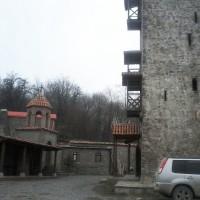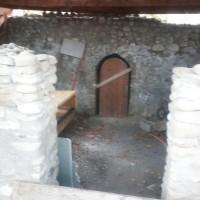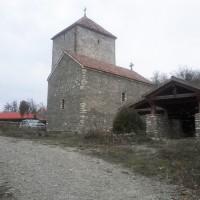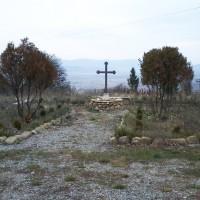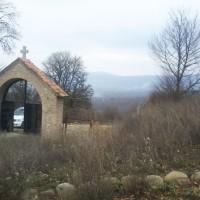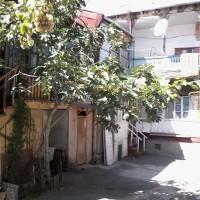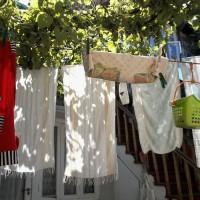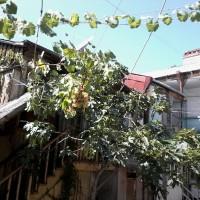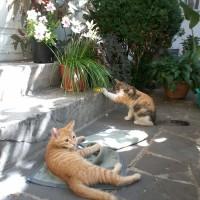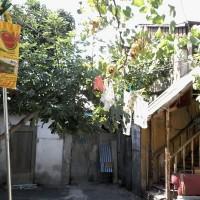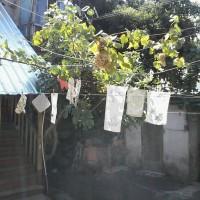The content of the article
Soul treatment
Georgia is one of the oldest Christian countries. Here, ancient monasteries and churches observe monumental, noble and severely the deeds of generations. One function of the monasteries is very interesting here; I will call it the healing of the soul. For example, if in Russia a person did not have a destiny or a family tragedy occurred, how does a man behave? It's no secret that many drink bitter. What's next? Narcology or coding. Treat what? Body. What about the soul? Leave the same torn. And here is another story.
In Georgia, it is customary to go to the monasteries for correction of body and soul for several months or years. It all depends on the person himself, on his condition. Moreover, they prefer monasteries far from the capital, high in the mountains or far in the forests. Sometimes they live not in the monastery itself, but nearby - in such huts-chapels. There is a garden here - they are subsistence farmers, they feed themselves, and also help the monastery. Of course, there are no special amenities at times. And the father (either a monk or a higher rank) instructs - gives advice, helps to love life again. Without vodka and depression.
Once my friends and I visited a house where several men lived. Their mission was to restore some ancient temple, and nearby was the monastery of Archil III. Of course, we were not allowed inside, but we walked around - an amazing place, looked into a church with bleached walls, looked at stone towers with rather angry balconies, an old wine cellar.
The monastery itself is very ancient, belongs to the 9th century. The first thing that comes to my mind when recalling is that it is easy to breathe there. A certain freedom and flight of consciousness. The buildings are located quite high, with a wide view of the fields and forests. Even the clouds are somehow nearby, as if enveloping these archaic buildings, sheltering and guarding modern hermits. I am sure that there, in merging with nature, the restless souls of men find harmony and peace.
Figurative language
I think that Georgian is a masculine language. Low guttural sounds, coupled with a temperamental delivery, are mesmerizing. When men speak, it sounds very sensual, when women speak rudely. I confess that at first I didn’t understand at all whether they were swearing or rejoicing, because the Georgians add all the facial expressions and gestures they are capable of to speech. And, as a rule, they speak loudly and sweepingly. But now, knowing very little Georgian vocabulary, I understand a lot thanks to this very southern picturesque, comprehensive conversational dynamics.
The language is very poetic, apt, with many shades. Ornate phrases, aphorisms or simply figurative expressions - this is constantly surprising. Translating, Georgians are lamenting - in Russian sometimes it doesn’t sound so beautiful. I smile, knowing the richness of my native language. However, I am pleased that they love their language so much - part and heritage of their centuries-old culture.
And in order not to be unfounded, I will give some examples of interesting Georgian expressions. Once my husband’s son told how to show his strength and dexterity. The example was not very at odds with the law and was aimed at enrichment at the expense of other people's funds. I frowned, wanted to give a lecture to a teenager. Did not make it. The boy, seeing my mood, hastened to say: “And you believed? Yes, I have the heart of a bird. If I offend anyone, I won’t survive: my heart will jump out of my chest. ”
Or such a case. Once, fingering Georgian names in a conversation with friends, she heard: “But this name is with a smell”. I still do not understand what it is. How can a word smell?
And I note Georgian humor. There is no way without it. Jokes and jokes are part of their mentality and language culture.Somehow, watching me, pregnant, crawling out of the car, puffing and waddling, my husband, by his kindness, could not resist and summed up “You, as the main host of Georgia!”
Country of Nuances
Georgians have very interesting names. There are both their own and borrowed. Bright, sonorous, sometimes difficult to pronounce: Mzia, Medea, Ginora, Manana, Sofiko, Tiniko. And men's - David, Roland, Vakhtang, Sandro, Zurab, George.
Like all nations, Georgians divide their names into metropolitan and provincial. On modern and outdated. After reading the reference books and listening to acquaintances, I thought that the locals unfairly attribute some names to outdated, unpopular or village ones. From which she concluded that we just as unfairly hang labels on very beautiful names.
But not only that surprised me. Again I found the unusual in the ordinary. For example, I know a girl whose name is Eka, and according to her passport she’s Catherine. And this is not an isolated case. This is here at every step. Or, for example, in a family I knew, they gave the daughter a name in tune with her first pronounced onomatopoeia. Now the woman is about thirty, she responds to Buba, and her real name ... But who looked into her passport? I do not even know.
I was also struck by one feature. Although Georgia is a post-Soviet country, the appeal to people here is completely different than in Russia. Patronymic usually do not indicate. They only call a person by name: whether he is a doctor, senior comrade, state official, etc. They can add a respectful “batono” and “Kalbatono” (Mr. - Mrs.). By the way, referring to teachers, schoolchildren simply add to the name as a prefix the first part of the word "mascavable" - "mas" ("teacher", that is, simply "uch").
And what’s absolutely unusual for me: children, turning to their parents, sometimes call them by name. Easy as friends. Every time I hear a similar familiarity, from my point of view, I open my mouth and freeze like a statue.
I also have personal experience with Georgian names. Rather, with their search. My husband completely refuses to pre-select the name of his daughter - a bad omen. The baby is about to be born, but we have no consensus! But the future father says calmly: “I’ll look at the child, how the girl will behave, what will hook her with interesting things - that’s what we’ll call her. Can you imagine my horror? Is this what a baby can hook on? At first, he only gets his diapers dirty and squeaks. I'm afraid to even imagine what my youngest will be called. Oh Georgia, a country of nuances!
Remarque (aside): You won’t take a Boatswain with your bare hands! I have strong arguments in reserve: men respect logic. And, to be honest, I have already chosen a name. And time will put everything in its place.
About the "Italian" courtyards
They are called so by analogy, but not objective, but abstract, meaning the temperament and clan lifestyle of Italians. What is so special about them? "Italian" courtyard - is a low stone house. It is like a holiday cake, with chaotically built tiers. Only in shape it is not round, but U-shaped, with iron forged gates that close at night. This is local space and forms a courtyard. Incredible design with a century of experience. Entrances and exits are entangled with wooden steep stairs, tiled balconies directed inside the courtyard, and clothesline for drying clothes. The vine twists around the roofs, awnings and gives a shady cool.
They say that earlier they were princely estates, into which ordinary people resettled with the advent of Soviet power. In each room - according to the family. Toilet and shower - outside, in the courtyard. A kind of communal apartment.
In old Georgian films, often the action takes place in such courtyards that successfully convey color, emphasizing the character and mentality. And simply because in such a courtyard the concentration of the population on insignificant square meters is huge. The roll call of housewives, the cries of children, the barking of dogs, the jokes of men - this is the everyday life of the “Italian” courtyard. Doors do not lock here, everyone lives in a large and noisy family: they have one for all joys and sorrows.
The "Italian" courtyards have been preserved in the old part of Tbilisi, now many of them are dilapidated, and most likely they will someday be demolished. Then the city will lose its picturesqueness and brightness. Remember “Farewell to Mater” or “White dew”? Something similar, sad and exciting will happen to people, and the truly Georgian, noisy and communal will disappear due to the loss of such buildings.
Thanks to the "Italian" courtyards, now you can still feel the spirit of ancient Tiflis.
And if someone has a holiday in such a courtyard - everyone is walking! The neighbors sit down at one big table, take out their supplies - who can bring what, pour homemade wine. And the bright, unbridled feast begins! Toasts are loud, enthusiastic, sometimes up to maximalism. However, like all Georgians, they cannot live in half measures. And after each toast, an exclamation: Gaumardjos! (Yes long live! So be it!)
By the way, my friend Alena and her family also live in an Italian courtyard. She jokes that she easily determines who has dinner for tonight. Alena herself masterly combines Russian and Georgian dishes. Today she shares a recipe for boiled fish and simply magical, versatile and beloved by all Georgians tkemali sauce.
Boiled trout and tkemali sauce from Alena Vatiashvili
To cook fish in Tbilisi, we need:
- 1-1.5 kg of fresh trout or mullet;
- 3 l of water;
- 1 carrot;
- 1 onion;
- Bay leaf;
- two branches of celery;
- 10 peas of allspice and black pepper;
- 4 tbsp. l salts;
- 100 g of wine vinegar.
We will cook trout.
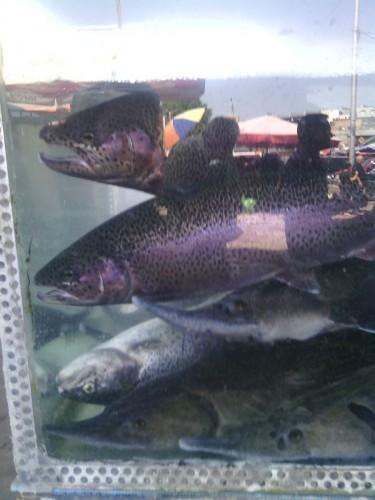
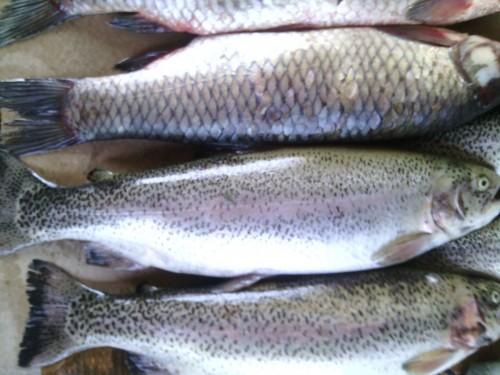
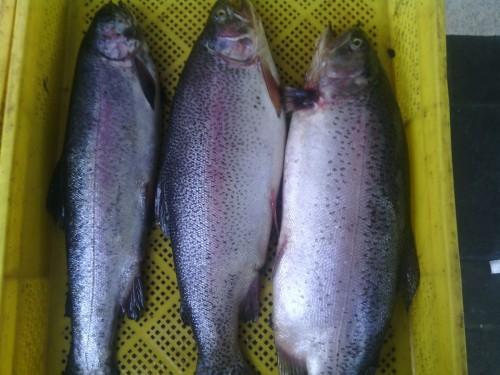
We clean fish from giblets. Cut into large pieces, wash and refrigerate for at least 4 hours.
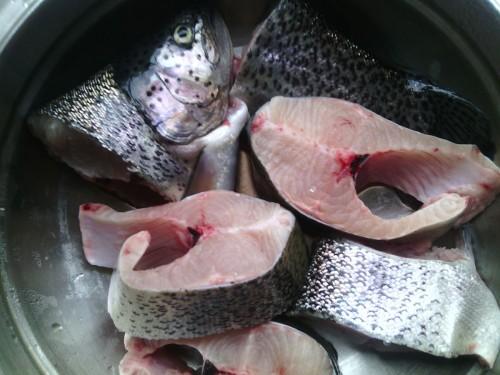
Next, pour water into the pan. We put there bay leaf, celery, peppercorns, carrots, onions, salt and vinegar.
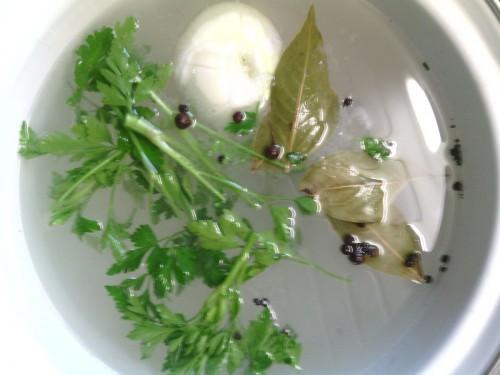
As it boils, put the pieces of fish and cook for 20 minutes over medium heat.
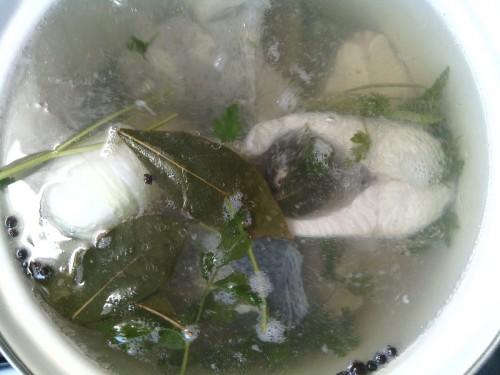
Then we catch trout with a slotted spoon and put it on a dish. Let cool and proceed to the tasting!
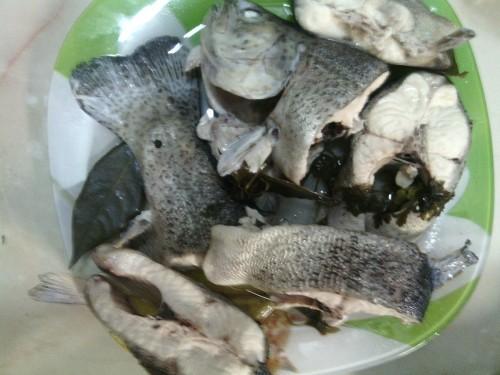
To make tkemali sauce we need:
5 kg of cherry plum;
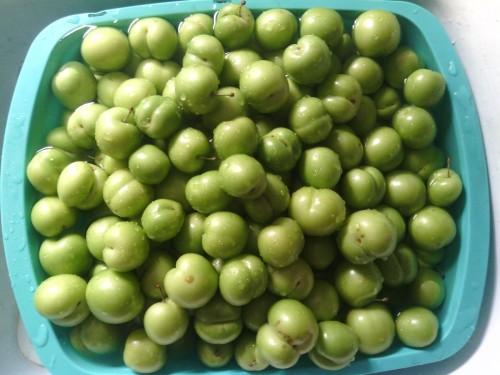
300 g of cilantro with seeds;
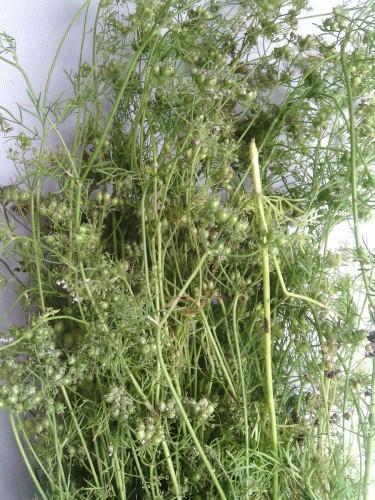
300 g ombalo (peppermint) - an essential ingredient that prevents fermentation;
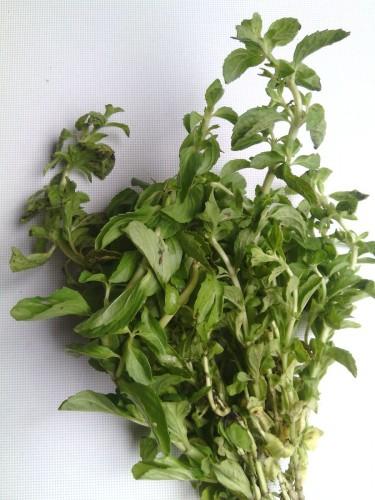
200 g of garlic;
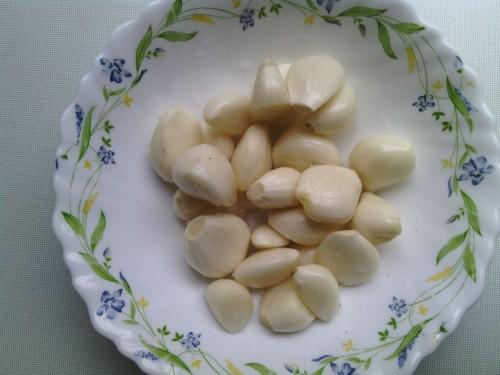
300 g of dill with seeds;
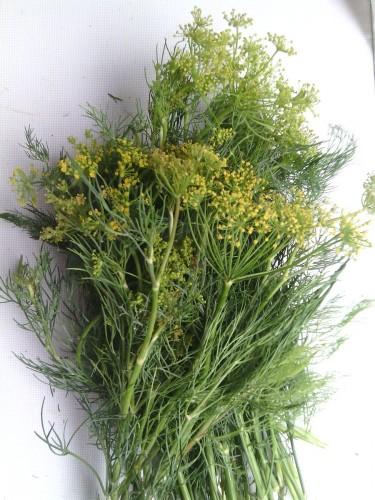
2 tsp. suneli (utkhosuneli, red flower, cilantro);
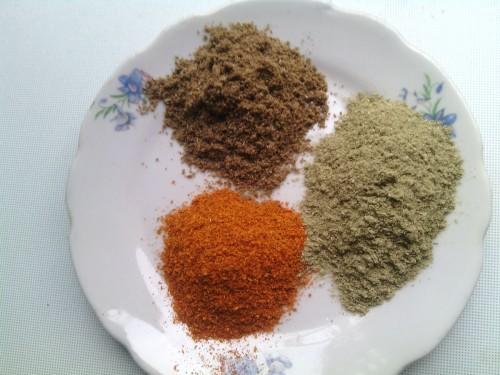
salt and red pepper to taste.
My cherry plum, pour into a pan with non-stick coating. Add 200 g of water, after boiling, cook for 20 minutes.
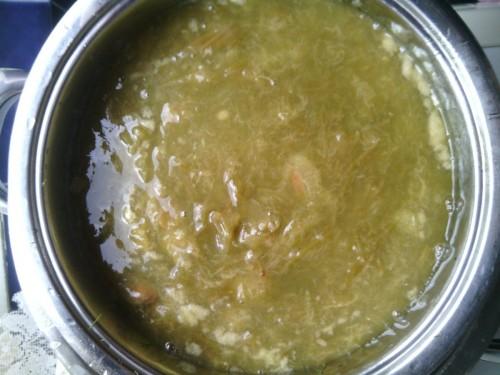
As the boiled cherry plum cools, we rub it through a colander.
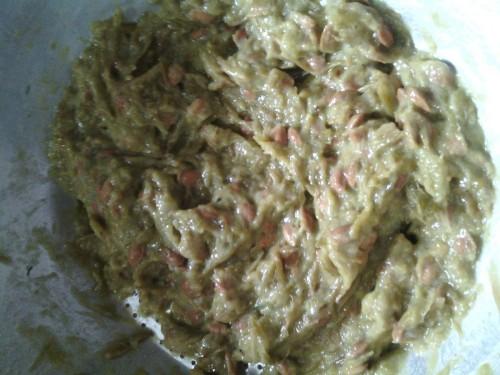
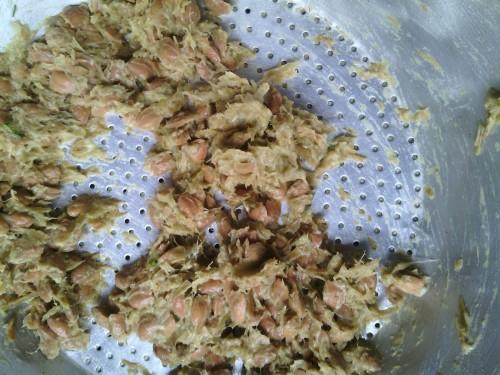
We transfer the ground mass into non-stick dishes. We wash the greens, peel the stems, grind in a blender along with garlic.
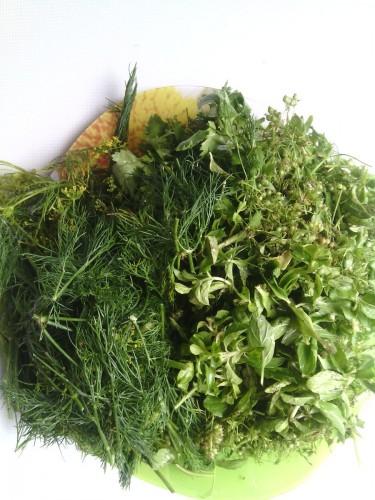
Put the chopped greens into the grated mass, put on fire and let it boil, while constantly stirring. Add salt and red pepper to taste. We boil for about 15-20 minutes until the foam ceases to appear.
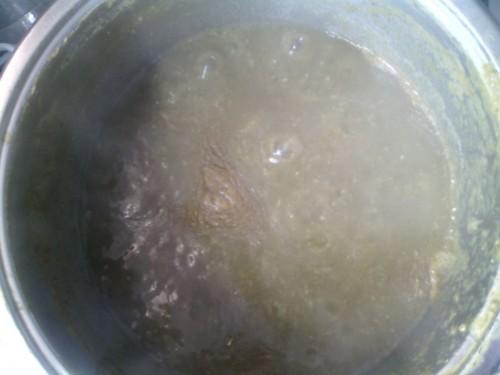
Next, pour into pre-sterilized banks, cover with metal lids and roll up.
Tkemali sauce is served with meat, fish, poultry, as well as side dishes: potatoes or pasta.
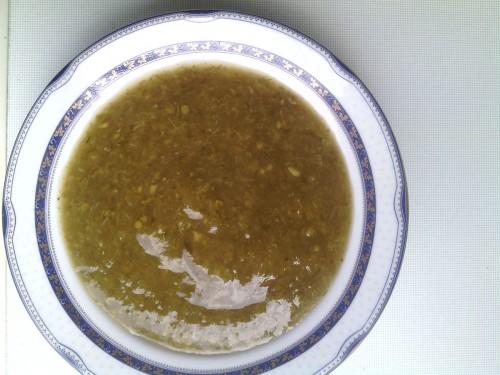
- Gemrielad is mivert! - Enjoy your meal!
